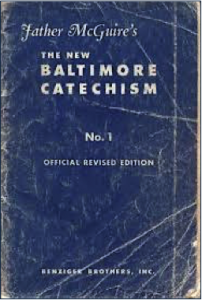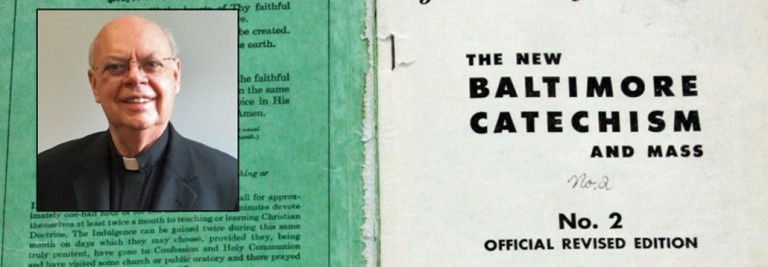Catholics of my generation . . . as told by Fr. Ashley Harrington . . . can remember vividly that first “take home” book. It was the first grade and Sister Mary had many books for her students to use—the reader that told the story of Dick and Jane, the book that taught how to form letters, the numbers book. But these were all books that were passed down from class to class. Then, one day Sister gave you a little blue book that you could not only take home but that you could keep. It was a book of theology! It was your first catechism.
The Baltimore Catechism consisted of deep questions and answers to be memorized. And, the questions and answers lingered in minds and hearts of the first graders for decades of their lives. Profound wisdom was absorbed at an early age. And that is deep theology.

Example from the Catechism: Why did God make you?Answer: God made me to know Him, to love Him and to serve Him in this world and to be happy with Him forever in the next.
It may surprise some that the early Christian community also had a first catechism. It was written about 60 years after the death of Jesus and only a few years after the Gospels. It was called The Lord’s Teaching or, in Greek, The Didache. The 2,500-word document is divided into three parts.
The first part sets forth a summary of the Christian ethics and morality. How should a Christian act? It states that there are two ways of living—the virtuous Way of Life and the wicked Way of Death. This, of course, reminds us of Jesus’ words “I am the Way. And the Truth. And the Life.” One teaching of Jesus that commands great attention in this first section is the mandate to love others as you love yourself. The negative is not to do to others what you would not want them to do to you. Among the prohibitions are murder, adultery, promiscuity, theft, abortion, infanticide, perjury, greed, hypocrisy and narcissism.
The second part of the catechism deals with the first Christian rituals; i.e., fasting, Baptism, and the Eucharist. The sacraments should be prefaced with fasting. Baptism is described as either immersion in living water (flowing water) or effusion (water poured over the head). The baptism is to be performed “in the name of the Father and of the Son and of the Holy Spirit.” The Eucharist is described as the central act of Christian worship. Two primitive Eucharistic prayers are given—one over the cup and one over the broken bread.
The third section deals with Church organization. It captures the transition from the disciples of Jesus acting as itinerant preachers to a system of local bishops and deacons. Guidelines are given to the faithful to discern a true Christian leader from a false one. Basically, a leader who fails to act according to what he is preaching is a false prophet.
Due to modern technology we all are able to have our own “take home” copy of this catechism. The text of The Didache is readily available on the Internet. It is well worth reading. This is a glimpse of what those first Christians thought and believed.
Recommendations:
- The full text of The Didache may be read at New Advent – The Didache.
- A 10-minute lecture on The Didache can be viewed on YouTube: Why Study The Didache by Tom O’Loughlin.
- A very interesting lecture on the history of the first Christians can be seen on YouTube: Church History Chapter 1 by Fr. John Hollowell.



